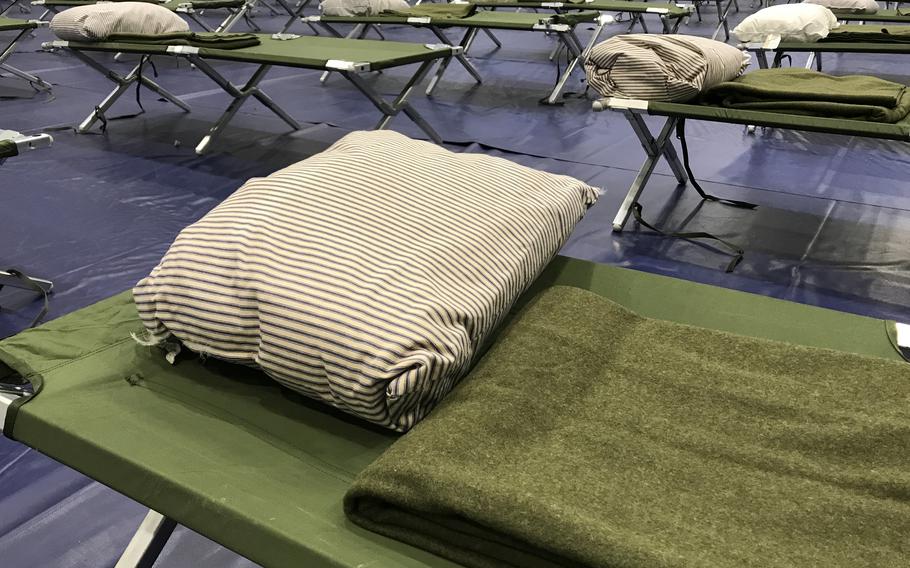
A runner takes advantage of slackening rain as Tropical Storm Shanshan churns near Marine Corps Station Iwakuni, Japan, Friday, Aug. 30, 2024. (Jonathan Snyder/Stars and Stripes)
TOKYO — The massive typhoon that churned ashore in southern Japan became a tropical storm by Friday but didn’t move far from its beachhead.
Tropical Storm Shanshan remained a slow-moving, unpredictable mass of wind and rain wallowing across two of Japan’s four main islands: southernmost Kyushu and the smallest, Shikoku.
Torrential rains inundated parts of southwestern and eastern Japan, reaching as far as Tokyo, where nearly 12 inches of rain had fallen, according to the Japan Meteorological Agency.
The Japanese government advised millions in Kyushu to leave their homes and at least three were killed and more than 80 injured, according to Japanese media. Traffic was snarled and low-lying areas flooded.

Rows of empty cots stand ready at an evacutaion center in the Northside Iron Works Gym at Marine Corps Air Station Iwakuni, Japan, Friday, Aug. 30, 2023. (Jonathan Snyder/Stars and Stripes)
A powerful Category 4-equivalent when it made landfall Thursday, Shanshan had withered a day later but still packed a punch, its reach felt nearly 300 miles away.
Central Japan Railway Co. suspended bullet train service to the south between Hiroshima and Hakata and to the north between Nagoya and Tokyo, according to its website Friday.
The meteorological agency warned of flooding and the risk of landslides due to heavy rain. Wind gusts flared periodically but rain bands spread as far as southern Nagano prefecture on the west side of Honshu, the largest main island, and Tokyo on the east side.
Yokohama, south of Tokyo, issued a landslide warning for vulnerable southern neighborhoods, according to a post Friday by Yokosuka Naval Base, headquarters for the 7th Fleet and Naval Forces Japan.
The warning did not immediately impact the Ikego Heights Housing Area, however, according to the naval base.
At Marine Corps Air Station Iwakuni, southwest of Hiroshima, the evacuation center set up inside the Northside Iron Works Gym was vacant and unused Friday but will remain open until Saturday. Light rain fell Friday, but forecasts carried the possibility of more to come.
Shanshan, centered about 60 miles southwest of the air base, remained unpredictable, with the potential to double back on itself, according to the Joint Typhoon Warning Center in Pearl Harbor, Hawaii.
Shanshan was “quasi-stationary,” and its track may deviate, “allowing for looping and possible backtracking that is not reflected on the forecast,” according to the joint center.
The storm was moving slowly to the northeast at about 2 ½ miles an hour, a walking pace, while trapped between two weaker atmospheric ridges, according to the center’s 11 a.m. Friday forecast.
See Stars and Stripes’ Pacific Storm Tracker for frequent updates on Shanshan.
Stars and Stripes reporters Jonathan Snyder contributed to this report.